NDVI stands for "Normalized Difference Vegetation Index". NRG stands for "Near-infrared / Red / Green". NDVI and NRG are both ways to visualize the amounts of infrared and other wavelengths of light reflected from vegetation. Because both these methods compare ratios of blue and red light absorbed versus green and IR light reflected, they can be used to evaluate the health of vegetation. It's a snapshot of how much photosynthesis is happening. This is helpful in assessing vegetative health or stress. (Read more here: https://www.agronomy.org/publications/jeq/articles/36/3/832) ## Do-It-Yourself These techniques for vegetation analysis were developed for satellite imagery, but at Public Lab, we've been working a lot on capturing infrared imagery using our DIY [near-infrared camera](/wiki/near-infrared-camera) setup, and combining it with visible bands to produce NDVI images such as the one above. ## What these images mean What exactly are these images we're trying to make? What do they tell us about vegetation, and why? These diagrams should help to understand what it is we're doing and why these are good ways to analyze plant life. ## The NDVI equation [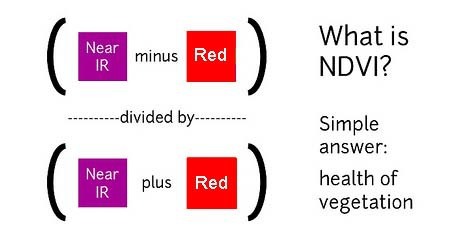](/i/44723) **NDVI = (Near Infrared - Red)/(Near Infrared + Red)** NDVI is a ratio which tries to emphasize photosynthesis while filtering out sun glare. The above equation is run for every pixel, using source data from an infrared photo and a visible light photo, like this pair: [](https://publiclab.org/system/images/photos/000/021/771/original/5390895115_c9d4d38fec_o.jpg) The result can be false-colored to make the high-photosynthesis areas more clear, and used to examine where plants are and how healthy they are. [](https://publiclab.org/system/images/photos/000/021/770/original/PetVISNDVIcomp.png) _Figure above: Normal color photo (right) and normalized difference vegetation index (NDVI) image (left). NDVI image was derived from two color channels in a single photo taken with a camera modified with a special infrared filter. Note that tree trunks, brown grass, and rocks have very low NDVI values because they are not photosynthetic. Healthy plants typically have NDVI values between 0.1 and 0.9. -- @cfastie_ ### Activities Here are a range of activities you can do to produce and interpret your own NDVI imagery, whether downloaded from a satellite imagery provider or [collected yourself using a DIY technique](/wiki/multispectral-imaging) [activities:ndvi] ****   Most DIY converted cameras today (those from Public Lab) use RGN instead of NRG, so the blue channel represents infrared instead of the red channel. That looks like this: [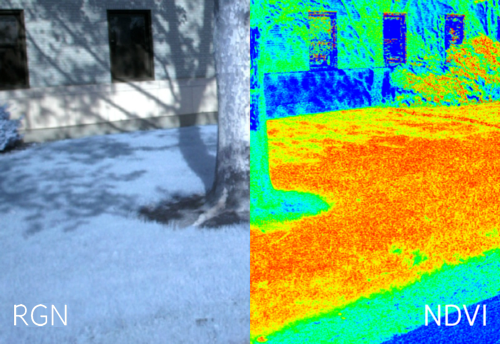](/i/45468?s=o) **** ## NRG imagery Some people are also interested in producing NRG imagery (like the below image), where `Near-Infrared, Red, and Green` are used to compose a picture instead of the usual `Red, Green, and Blue`. [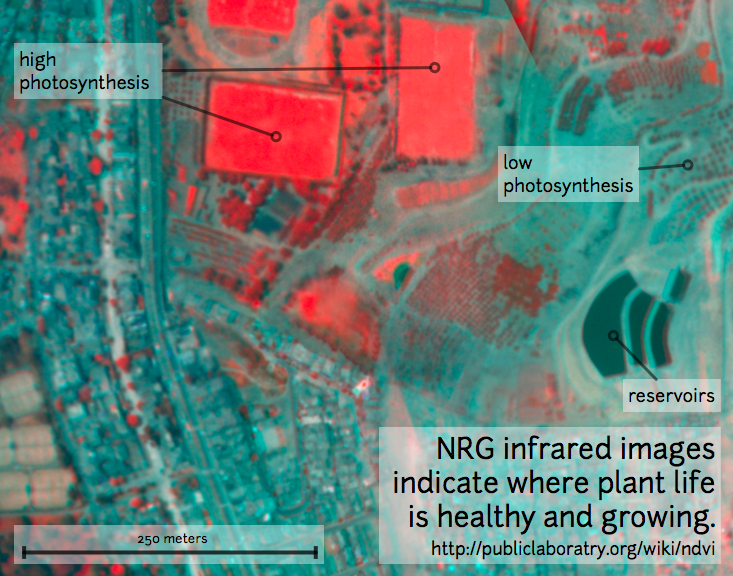](/i/25064) This diagram explains the swapping, which allows us to 'see' infrared as if it were a normal color: [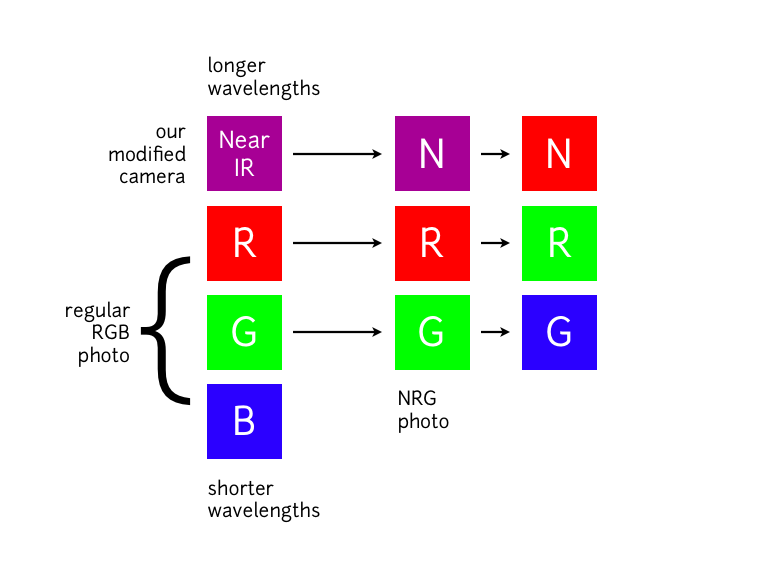](/i/25063) **In NRG images, the deeper and clearer the red color, the denser and healthier the vegetation (more or less).** ### Questions [questions:ndvi] ### Other examples of DIY NDVI imaging From around the internet: Begin watching at 2 minutes to see the resulting imagery: *This topic is part of the [Grassroots Mapping Curriculum](/wiki/mapping-curriculum) series.* **** [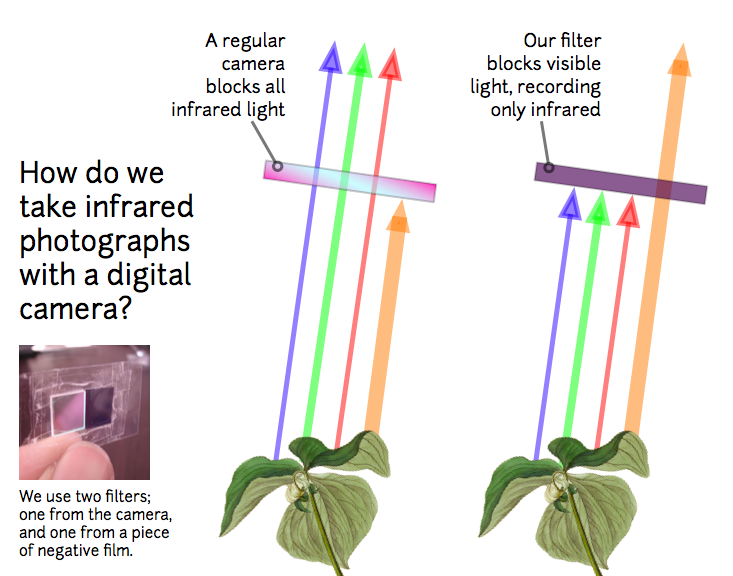](/i/25066) [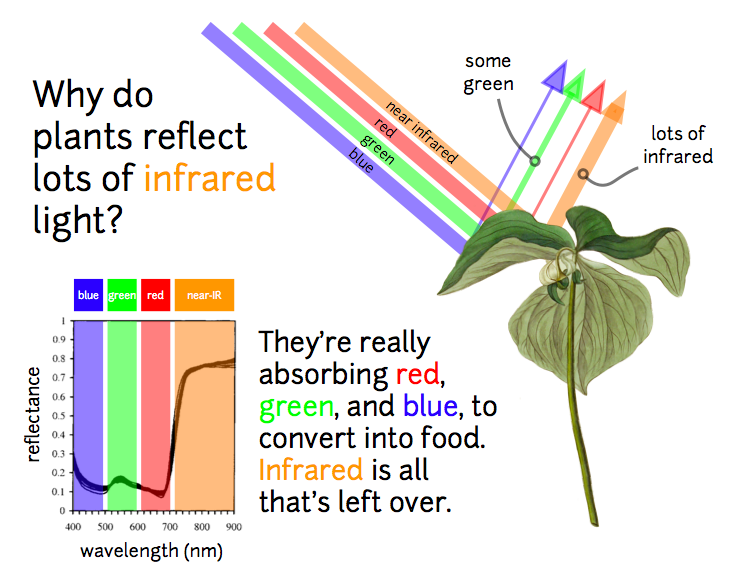](/i/25065) ...
| Author | Comment | Last activity | Moderation | ||
|---|---|---|---|---|---|
| cfastie | "1) When you said shortcut, you meant I could for example use a blue led or a blue paint as target? Or do you have another suggestion? An LED or ot..." | Read more » | over 8 years ago | |||
| carolccarvalho | "Hi Chris, thank you very much for the help! I'll choose better times and avoid shadows the next flight. And I'll try correcting the exposure too! ..." | Read more » | over 8 years ago | |||
| Davidkao | "Thank you very much for the advice Chris and Ned, I have learned a lot. I will continue to this research, so if possible if I encounter any problem..." | Read more » | over 8 years ago | |||
| cfastie | "David, When using a blue (#2007) filter, the red channel records NIR and the blue channel records visible blue light which is used to compute NDVI...." | Read more » | over 8 years ago | |||
| nedhorning | "Hi David - This is an interesting project. The reflection of the glass should affect the results as long as the reflection is not in the area of yo..." | Read more » | over 8 years ago | |||
| everydayduffy | "Thank you @Claytonb. " | Read more » | over 8 years ago | |||
| Davidkao | "Hello, @nedhorning, I had recently been researching about NDVI and came across your amazing calibration plugin. It works great; however I have a fe..." | Read more » | over 8 years ago | |||
| cfastie | "Those NDVI images look reasonable. Deep shadows are not being handled very well so they are assigned NDVI values of 1.0 (magenta) or apparently -1...." | Read more » | over 8 years ago | |||
| Claytonb | "@everydayduffy -For the above comparison I used the calibration option in Pix4D pro. It consisted of drawing a region of interest on the image of t..." | Read more » | over 8 years ago | |||
| everydayduffy | "Thanks @Claytonb for this really interesting post. Could you detail a bit more about how you calibrated your images with reflectance targets please? " | Read more » | over 8 years ago | |||
| warren | "I really liked this note too! I'm interested in how this dataset could be used as a "test set" for software development as well. There are a range ..." | Read more » | over 8 years ago | |||
| cfastie | "ImageJ and Fiji have very powerful tools for extracting, summarizing, and displaying the NDVI values in the floating point images produced by Ned's..." | Read more » | over 8 years ago | |||
| ahcalori | "@cfastie. I think you are right. The problem must be the filters. I will open the cam and see what happens. I'm just using the product the way I bo..." | Read more » | over 8 years ago | |||
| cfastie | "The color gradient in the photos taken by your modified camera seems to be the cause of the artifacts in your NDVI image. To determine whether this..." | Read more » | over 8 years ago | |||
| ahcalori | "Hi, dear @cfastie, the webcam that I have been used is described in the follow link: https://www.adafruit.com/product/1722. The filter used allow ..." | Read more » | over 8 years ago | |||
| Claytonb | "Hi Alex, I would recommend contacting Charlie Langlois at Labsphere- clanglois@labsphere.com They can make affordable($300 range)targets that are s..." | Read more » | over 8 years ago | |||
| admaltais | "Hi Claytonb, Really interesting analysis. I currently use a Canon S110 modified by Sensfly for NDVI and I wondered if there could be a big differen..." | Read more » | over 8 years ago | |||
| ahcalori | "@cfastie, Is not the Mobius camera. Is just one with modified filters. I will post the specification here. Thanks! " | Read more » | over 8 years ago | |||
| cfastie | "Although the diagonal color gradient is not conspicuous in the NDVI image, it is present in the NIR photo (pinkish in the lower left and bluish in ..." | Read more » | over 8 years ago | |||
| ahcalori | "@cfastie, Thanks for reply. The camera that has been used is one bought in the 'Public Lab Store'. The curious fact is that some pics does not has ..." | Read more » | over 8 years ago | |||
| cfastie | "The color gradient in the NIR photo from lower left to upper right is conspicuous.This could be caused by the ambient lighting or by the camera. Wi..." | Read more » | over 8 years ago | |||
| cfastie | "The flexible PVC tubing is exactly the right size to slip inside the third smallest carp pole section. To stiffen the connection I insert a length ..." | Read more » | over 8 years ago | |||
| ggallant | "I'm impressed but I would have been AWED if it had been done with levitation. " | Read more » | over 8 years ago | |||
| tonyc | "You do have a rye sense of humor, Chris. A groan is my highest compliment. Some people prefer laughs, but I'm a groan man. Did you just tape the P..." | Read more » | over 8 years ago |